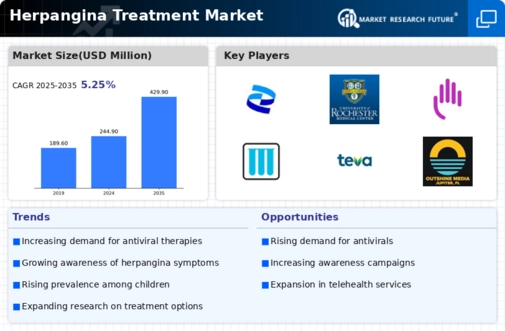Increasing Incidence of Herpangina
The rising incidence of herpangina, particularly among children, appears to be a primary driver for the Herpangina Treatment Market. Recent data indicates that herpangina cases have been on the rise, with estimates suggesting that millions of children are affected annually. This increase in cases necessitates effective treatment options, thereby propelling market growth. Healthcare providers are increasingly focusing on developing and implementing treatment protocols to address this condition. The heightened awareness among parents regarding the symptoms and potential complications of herpangina further contributes to the demand for treatment solutions. As a result, pharmaceutical companies are likely to invest in research and development to create innovative therapies, which could enhance the overall landscape of the Herpangina Treatment Market.
Increased Focus on Preventive Healthcare
The increased focus on preventive healthcare is emerging as a vital driver for the Herpangina Treatment Market. Healthcare systems worldwide are shifting towards preventive measures to reduce the incidence of infectious diseases, including herpangina. This shift is characterized by enhanced public health campaigns aimed at educating parents about hygiene practices and the importance of vaccination. Although there is currently no vaccine specifically for herpangina, the promotion of general health practices can potentially reduce the spread of the viruses that cause the condition. Consequently, this proactive approach may lead to a decrease in herpangina cases, thereby influencing the demand for treatment options. As healthcare providers emphasize prevention, the Herpangina Treatment Market may witness a transformation in how treatments are approached, focusing on both management and prevention.
Growing Investment in Pediatric Healthcare
The growing investment in pediatric healthcare is another significant driver for the Herpangina Treatment Market. Governments and private entities are increasingly allocating resources to improve healthcare services for children, recognizing the unique health challenges they face. This trend is reflected in the establishment of specialized pediatric clinics and the expansion of healthcare facilities that cater specifically to children. Such investments not only enhance access to healthcare but also promote the development of targeted treatments for conditions like herpangina. Furthermore, the emphasis on preventive care and early intervention in pediatric health is likely to lead to increased screening and diagnosis of herpangina, thereby driving demand for effective treatment options within the Herpangina Treatment Market.
Rising Demand for Over-the-Counter Treatments
The rising demand for over-the-counter (OTC) treatments is influencing the Herpangina Treatment Market significantly. Parents often seek immediate relief for their children experiencing symptoms of herpangina, such as sore throat and fever. As a result, there is a growing preference for OTC medications that can alleviate these symptoms without the need for a prescription. This trend is supported by the increasing availability of OTC products specifically formulated for pediatric use. The convenience and accessibility of these treatments are likely to enhance their appeal among caregivers, thereby driving sales in the Herpangina Treatment Market. Additionally, the marketing strategies employed by pharmaceutical companies to promote these products may further contribute to their uptake, indicating a shift in consumer behavior towards self-medication for herpangina.
Technological Advancements in Drug Development
Technological advancements in drug development are poised to play a crucial role in shaping the Herpangina Treatment Market. Innovations in biotechnology and pharmacology are enabling researchers to explore new therapeutic avenues for treating herpangina. For instance, the development of antiviral medications and novel formulations could potentially enhance treatment efficacy and reduce recovery times. Moreover, the integration of artificial intelligence in drug discovery processes may expedite the identification of effective compounds against the viruses responsible for herpangina. As these technologies continue to evolve, they are likely to attract investment from pharmaceutical companies, fostering a competitive environment within the Herpangina Treatment Market. This dynamic landscape may lead to the introduction of more effective and targeted treatment options for patients.


















Leave a Comment